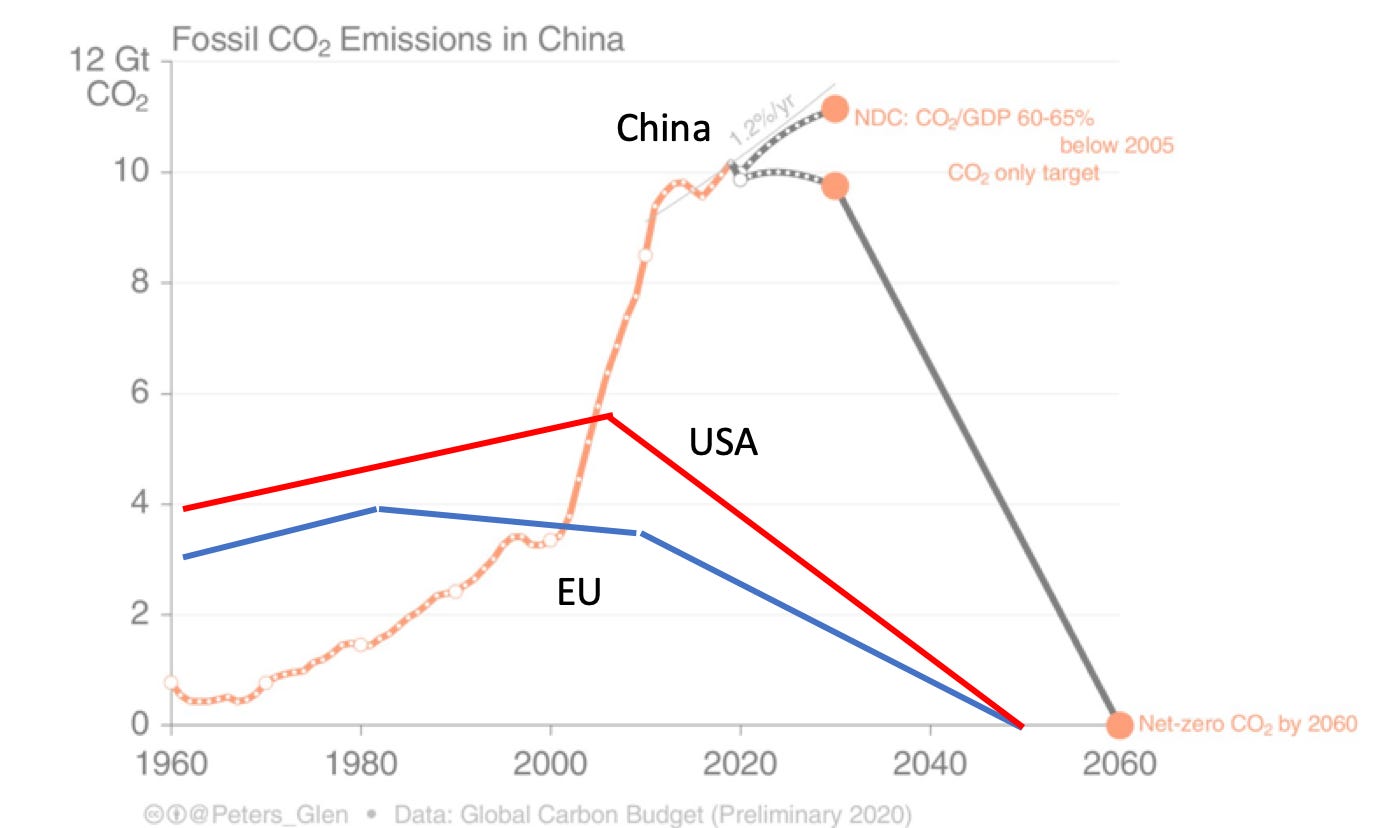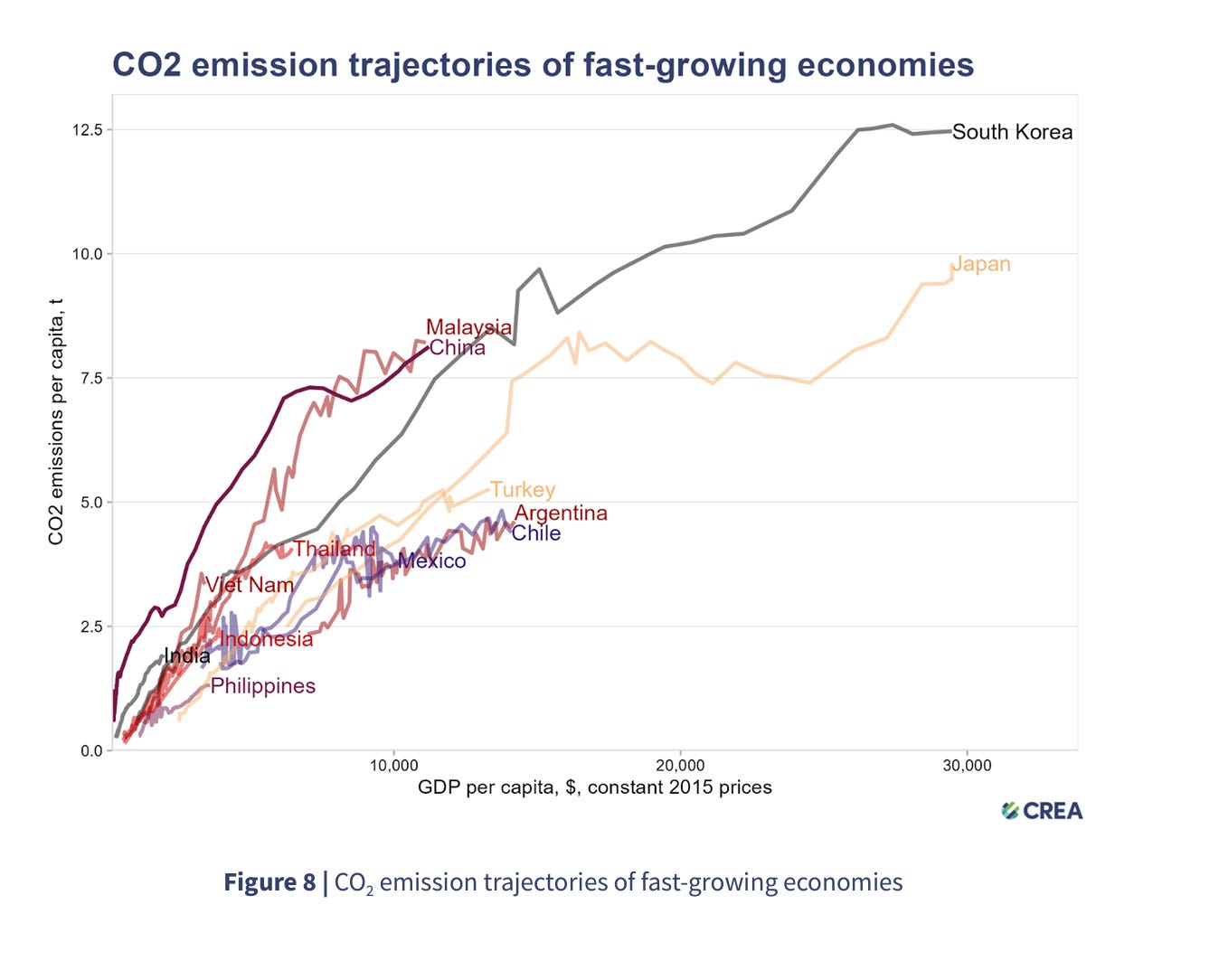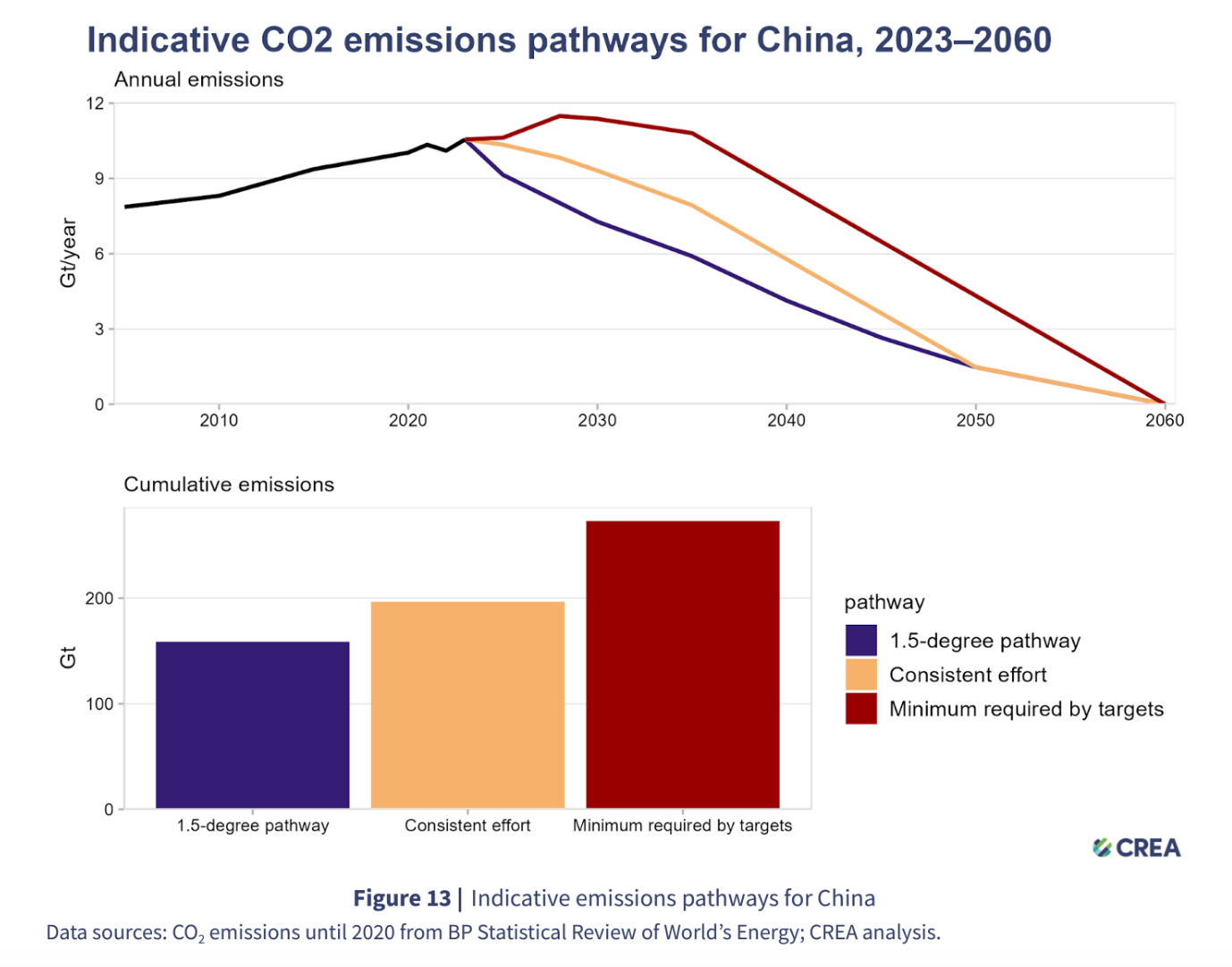Chartbook Carbon Notes 11 China's energy transition path and the global carbon budget
China is the worldʼs largest greenhouse gas emitter, and the second-largest historical emitter, after the United States. In 2021, it produced 27% of global greenhouse gas emissions, with around 18% of the worldʼs population and GDP. Chinaʼs share of global emissions rose to this level from less than 10% in 1990. China was responsible for 73% of the increase in global CO 2 emissions from 2010 to 2022
This comes from the in-depth report on China’s Climate Transition issued by the Center for Research on Energy and Clean Air (CREA) supported by the Heinrich Böll Foundation and authored by Lauri Myllyvirta, Qi Qin, Chengcheng Qiu and Xinyi Shen.
In September 2020 China committed to climate neutrality by 2060. Subsequently it committed to peaking emissions before 2030.
Though the Western polluters have set their sights on 2050 and their emissions peaked long ago, the trajectory that China has set its sights on is, is not less but far more ambitious than anything envisioned in the West. Heuristically the net zero paths of China, the USA and the EU might be compared as follows.
What China is embarking on is not so much an energy transition as an energy hairpin.
Understanding the relative dimensions and contours of these different paths is essential to understanding what is at stake in the global energy transition. Assuming we have the good fortune of being able to look back on this process from the vantage point of 2070 or 2080, the drama of the energy transition will not to be found in the West, but in Asia, in China’s hairpin and the efforts by India and other developing countries to find paths to growth that do not make them into more Chinas.
As this graph makes clear, smaller but none the less important challenges also face Japan and South Korea.
But it is China that dominates the global equation. Given the scale of China’s emissions what matters is not just the end point - net zero by 2060 - but the shape of the trajectory on which it travels to that point. Beyond the overall scale and the contour of the energy path, it is also the timing and the precise shape that matter. What counts for climate change is accumulated emissions and in terms of our graphics that will be defined by the “space under the curve”.
As the CREA report makes clear, the shape of the transition is underdetermined by current Chinese policy.
The increase in CO 2 emissions is currently constrained by the CO 2 intensity and non-fossil energy targets for 2025 and 2030, the energy intensity target for 2025 and the commitment to peak CO 2 emissions before 2030. The targets, however, leave room for a substantial increase in CO 2 emissions from 2020 to 2030, of up to 15%, assuming a 5% average GDP growth rate in 2021–2030. Emissions could increase even more by the late 2020s and then fall to meet the peaking target and the 2030 targets. There are no numerical targets in place for the rate of emissions reductions after the peak, leaving the trajectory of emissions from the peak to carbon neutrality sometime before 2060 wide open.
The range of cumulative emissions that is compatible with China’s current climate commitment is alarmingly large. As the CREA report spells it out.
The pathway labelled “minimum required by targets” shows the highest possible emissions pathway that China could follow while meeting the 2025 and 2030 CO 2 intensity targets and the commitment to peak emissions before 2030. After 2030, emissions fall slowly and gradually, requiring very rapid reductions in the 2040s and 2050s. This does not violate Chinaʼs commitments but results in large cumulative emissions and does little to demonstrate the commitment to the long-term goal over the next two decades. The “consistent effort” pathway shows a path to the carbon neutrality target in which emissions plateau until 2025 and start falling therea er, avoiding a large change in the amount of effort required in the following decades. The 1.5°C pathway would be extremely challenging to achieve, but it is what China and other countries should strive towards based on the Paris Agreement.
Cumulative emissions between 2023 and 2060 are 160 Gt under the crash effort to achieve 1.5 degree conformity - compared to 10-11 Gt per annum at the current rate. The “consistent” effort path yields, 200 Gt in cumulative emissions and the “minimum effort” path implies 270 Gt of cumulative emissions.
To be clear, all of these paths require spectacular reductions relative to the current emissions of 11 Gt per annum. The minimum effort path implies an average annual emission over the coming 37 years of 7.3 Gt i.e. roughly 30-40 percent below current levels. On the crash path the cut is to an average of 4.3 Gt i.e. a 60 percent cut.
To gauge the significance of that variation, compare the range of China’s future cumulative emissions with the global carbon budget that remains if we aspire to achieving climate stabilization.
To have a 50% chance of keeping global warming below 1.5 degrees, as of January 2023 we had 250 Gt remaining. To have a two thirds chance of stabilizing at 2 degrees we have 940 Gt remaining.
This makes clear why the 1.5 degree scenario is now so implausible.
Making heroic assumptions about the energy transition - allowing China’s emissions to be held to 160 Gt - China’s emissions by 2060 account for 64 percent of the remaining global carbon budget. That is a balance that will not hold.
If we assume that China does the minimum required to meet its current targets for 2030 and 2060 and the rest of the world does what is necessary for 2 degree stabilization, then China will, by 2060, account for 27 percent of the remaining carbon budget. This scenario effectively sees the current imbalance in global emissions dominated by Chinese heavy industry, inscribed into the global climate stabilization path. If this were to transpire, the rich world would have little to complain about, but the same is not true of developing countries, which want to claim a larger share of the remaining carbon budget than they currently consume.
To make room for rising emissions in the developing world requires a more significant effort both on the part of China and the West.
How far might that go?
If we manage to keep the world economy within the 940 Gt envelope and China makes a crash effort at decarbonization and holds its cumulative emissions to only 160 Gt, this would imply that we have a good chance of stabilizing at 2 degrees with China taking a 17 percent share of the remaining carbon budget, roughly in line with its share of global population.
Unfortunately, this is a scenario that is very unlikely given current trends. China is currently witnessing a historic surge in clean energy investment combined with ongoing coal and fossil fuel consumption at very high levels. This is far from the crash path needed to minimize total cumulative emissions.
Assuming that China sticks to its overall targets this implies either that we achieve climate stabilization around 2 degrees by 2050-2060 at the expense of developing world claims on the carbon budget. Or, we exceed the stabilization budget for 2 degrees and end up in an even hotter world.
***
Thank you for reading Chartbook Newsletter. It is rewarding to write. I love sending it out for free to readers around the world. But it takes a lot of work. What sustains the effort are voluntary subscriptions from paying supporters. If you are enjoying the newsletter and would like to join the group of supporters click below. As a token of appreciation you will receive the full Top Links emails several times per week.





My view is this is way too pessimistic about China’s emissions trajectory. One, the massive infrastructure build is over, particularly residential construction. Two, you have a rapidly aging and declining population, (old people don’t consume as much, particularly new housing), three you have far and away the world’s largest renewable energy buildout—driven by strategic concerns about dependence on oil and gas needing to transit the South China Sea, and fourth, the reservoirs are refilling and a lot of coal plant buildout was to make up for lack of hydro during the past couple bad years. Right now massive buildout of facilities for producing plants for renewable linked production, and the energy intensive production of these batteries and solar panels is driving the coal emissions. The rapid buildout of nuclear should take over this base load. Finally steel has been a huge contributor, but with many projects moving from construction to tear down there should be a lot of scrap steel for electric arc furnace steel production which is much less emitting. I’m an optimist that expects a dramatic decline curve much sooner than expected driven by the demographic chance and the economic growth decline—and the renewable and nuclear buildup.
Shame on the West for taking so long to act on climate change and even now, having per capita emissions that far exceed those in China and the global south. Shame on the West for even now obstructing China’s efforts by engaging in trade wars. Shame on the West for not providing financial grants to help China and the Global South transform their economies. You are like the rich man, with Lazarus at your gate. Not lifting a finger to help, only ready to point an accusing finger at the poor.